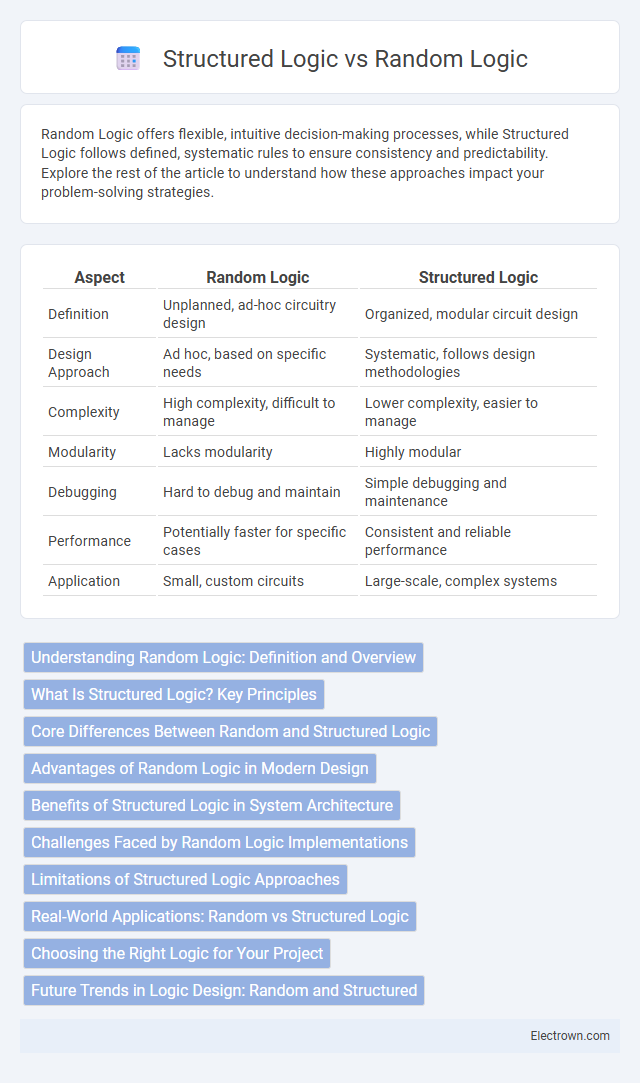Random Logic offers flexible, intuitive decision-making processes, while Structured Logic follows defined, systematic rules to ensure consistency and predictability. Explore the rest of the article to understand how these approaches impact your problem-solving strategies.
Table of Comparison
| Aspect | Random Logic | Structured Logic |
|---|---|---|
| Definition | Unplanned, ad-hoc circuitry design | Organized, modular circuit design |
| Design Approach | Ad hoc, based on specific needs | Systematic, follows design methodologies |
| Complexity | High complexity, difficult to manage | Lower complexity, easier to manage |
| Modularity | Lacks modularity | Highly modular |
| Debugging | Hard to debug and maintain | Simple debugging and maintenance |
| Performance | Potentially faster for specific cases | Consistent and reliable performance |
| Application | Small, custom circuits | Large-scale, complex systems |
Understanding Random Logic: Definition and Overview
Random Logic refers to a design approach in digital circuits where logic gates are directly connected to implement specific functions without a regular pattern or modular structure. This technique is often used in custom or application-specific integrated circuits (ASICs) to optimize performance for particular tasks by minimizing gate delays and power consumption. Unlike structured logic, random logic allows more flexibility in circuit design but can lead to increased complexity in layout and testing.
What Is Structured Logic? Key Principles
Structured logic refers to a systematic approach in digital circuit design where logic components are organized into well-defined modules with clear interfaces, enhancing readability and maintainability. Key principles include modularity, predictable timing, and hierarchical design, which collectively improve scalability and debugging efficiency. This method contrasts with random logic by emphasizing regularity and reuse, leading to optimized performance and easier verification in complex systems.
Core Differences Between Random and Structured Logic
Random logic relies on a non-regular, unpredictable interconnection of logic gates, enabling compact and fast circuit designs for specific functions. Structured logic, in contrast, uses predefined, regular arrangements of gates such as arrays or blocks, enhancing modularity and ease of design verification. The core difference lies in random logic's flexibility for custom, optimized circuits versus structured logic's predictable, scalable framework supporting systematic design approaches.
Advantages of Random Logic in Modern Design
Random logic offers significant advantages in modern design by enabling highly optimized, customized circuits that reduce gate count and improve overall chip area efficiency. Its flexibility allows for rapid implementation of complex functions, enhancing performance and lowering power consumption compared to traditional structured logic. This adaptability is particularly beneficial in advanced microprocessor and ASIC designs where speed, power efficiency, and space constraints are critical.
Benefits of Structured Logic in System Architecture
Structured logic enhances system architecture by providing predictable behavior and easier debugging through predefined control flow patterns. It improves code maintainability and scalability by organizing complex processes into modular, reusable components. This approach also facilitates optimized resource allocation and enhances system reliability by reducing unintended interactions typical in random logic designs.
Challenges Faced by Random Logic Implementations
Random logic implementations often face challenges such as increased difficulty in debugging and verification due to their non-regular, unpredictable circuit patterns. This complexity can result in longer design times and higher risks of errors compared to structured logic, which uses regular and predictable design blocks. Your design process may also encounter scalability issues and inefficient resource utilization when relying heavily on random logic approaches.
Limitations of Structured Logic Approaches
Structured logic approaches face limitations such as reduced design flexibility and difficulty managing complex, non-linear problems due to their rigid architecture. They often require extensive preprocessing and predefined workflows, which hinders adaptability in dynamic or evolving systems. This inflexibility can result in longer development cycles and challenges in optimizing performance for specialized applications compared to random logic designs.
Real-World Applications: Random vs Structured Logic
Random logic finds extensive use in microprocessor control units where flexible, unpredictable decision-making pathways enhance instruction decoding efficiency. Structured logic, characterized by predictable and hierarchical circuit design, dominates applications requiring reliability and scalability such as memory controllers and digital signal processors. Complex systems often integrate both, leveraging random logic for customized control functions and structured logic for standardized data processing tasks.
Choosing the Right Logic for Your Project
Selecting the appropriate logic design--Random Logic or Structured Logic--depends on your project's complexity and performance requirements. Random Logic offers faster execution with optimized gate arrangements, ideal for high-speed, custom processors, while Structured Logic provides modularity and easier debugging, suited for larger, scalable systems. Assessing your project's goals and constraints helps ensure efficient implementation and optimal resource utilization.
Future Trends in Logic Design: Random and Structured
Future trends in logic design emphasize the integration of random logic with structured logic to optimize circuit performance and scalability. Advanced algorithms and machine learning techniques are improving the synthesis and verification processes, enabling more efficient handling of complex designs. Your ability to leverage these hybrid approaches will accelerate the development of high-speed, low-power digital systems.
Random Logic vs Structured Logic Infographic

 electrown.com
electrown.com